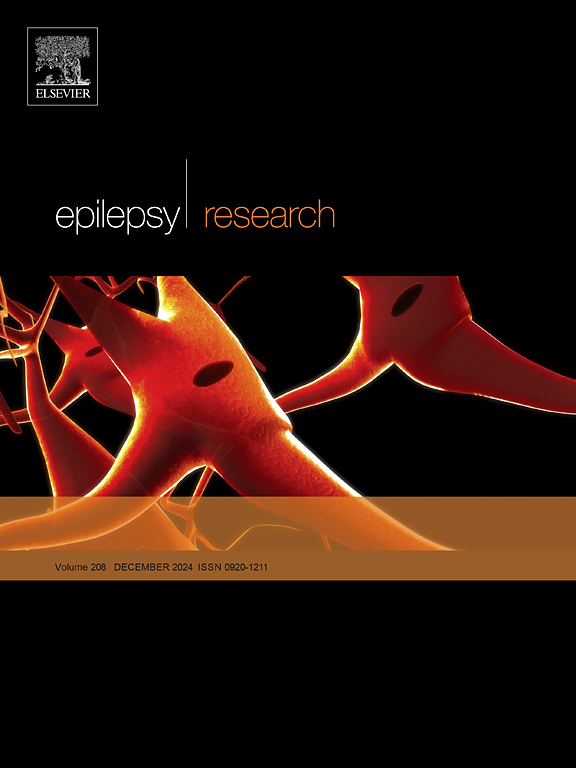一种简单可靠的脑电图蒙太奇,用于检测和管理急性脑炎和脑病儿童的脑电图发作
IF 2
4区 医学
Q3 CLINICAL NEUROLOGY
引用次数: 0
摘要
背景连续脑电图(EEG)监测(C-EEG)对于急性脑炎和脑病患儿电痉挛(ESz)的早期诊断和治疗至关重要。然而,在日本,像许多其他国家一样,C-EEG并没有被广泛使用,因为它依赖于专业的医生和技术人员来应用国际10-20全电极EEG (FE-EEG)系统。因此,本研究旨在评估一种简单可靠的简化脑电图蒙太奇。方法回顾性分析2015年至2020年期间使用FE-EEG进行C-EEG检查的83例发热伴癫痫持续状态或发热伴意识障碍患者。排除41例诊断为发热性癫痫持续状态的患者后,纳入42例诊断为急性脑炎或脑病的患者。其中,2例患者被排除,因为他们的脑电图显示发作-间期连续,排除了准确的癫痫计数。最后,本回顾性研究纳入了15例超过5例ESz的患者。我们将FE-EEG记录的EEG数据重新格式化为三个简化的蒙太奇:双距离减少EEG (RE-EEG),发际线EEG (Hairline)和振幅集成EEG (aEEG),每个半球分别包含4个,3个和1个EEG通道。用泊松回归分析比较这些简化蒙太奇的ESz检出率。结果42例急性脑炎或脑病患者中,15例出现5次以上ESz。RE-EEG检测ESz与FE-EEG无显著差异。此外,RE-EEG的ESz检出率明显高于发际线和aEEG蒙太奇。结论re - eeg对癫痫发作的检出率可靠,除1例外均超过90% %。除了检测ESz外,RE-EEG还可以作为一种快速、方便、临时的脑功能监测手段,在资源有限的医疗环境中具有巨大的应用潜力。本文章由计算机程序翻译,如有差异,请以英文原文为准。
A simple and reliable electroencephalogram montage for detecting and managing electrographic seizures in children with acute encephalitis and encephalopathy
Background
Continuous electroencephalogram (EEG) monitoring (C-EEG) is crucial for the early diagnosis and treatment of electrographic seizures (ESz) in children with acute encephalitis and encephalopathy. However, in Japan, like many other countries, C-EEG is not widely accessible due to reliance on specialized physicians and technicians to apply the international 10–20 system for full-electrode EEG (FE-EEG). Therefore, this study aimed to evaluate a simple and reliable reduced EEG montage.
Methods
We retrospectively analyzed 83 patients presenting with fever and status epilepticus or fever and impaired consciousness who underwent C-EEG using FE-EEG between 2015 and 2020. After excluding 41 patients diagnosed with febrile status epilepticus, 42 diagnosed with acute encephalitis or encephalopathy were included. Of these, two patients were excluded because their EEGs demonstrated an ictal-interictal continuum, precluding accurate seizure counting. Finally, 15 patients who had more than five ESz were included in this retrospective study. We re-formatted the EEG data recorded with FE-EEG into three reduced montages: double-distance reduced EEG (RE-EEG), Hairline, and amplitude-integrated EEG (aEEG), comprises 4, 3, and 1 EEG channel(s) on each hemisphere, respectively. The ESz detection rates of these reduced montages were compared using Poisson regression analysis.
Results
Among 42 patients with acute encephalitis or encephalopathy, 15 exhibited ESz more than five times. RE-EEG detected ESz with no significant difference compared to FE-EEG. Furthermore, RE-EEG demonstrated a significantly higher ESz detection rate than the Hairline and aEEG montages.
Conclusion
RE-EEG offered a reliable seizure detection rate exceeding 90 %, except for one case. Beyond detecting ESz, RE-EEG could serve as a quick, convenient, and temporary monitor for brain function, offering significant potential for implementation in resource-limited healthcare settings.
求助全文
通过发布文献求助,成功后即可免费获取论文全文。
去求助
来源期刊

Epilepsy Research
医学-临床神经学
CiteScore
0.10
自引率
4.50%
发文量
143
审稿时长
62 days
期刊介绍:
Epilepsy Research provides for publication of high quality articles in both basic and clinical epilepsy research, with a special emphasis on translational research that ultimately relates to epilepsy as a human condition. The journal is intended to provide a forum for reporting the best and most rigorous epilepsy research from all disciplines ranging from biophysics and molecular biology to epidemiological and psychosocial research. As such the journal will publish original papers relevant to epilepsy from any scientific discipline and also studies of a multidisciplinary nature. Clinical and experimental research papers adopting fresh conceptual approaches to the study of epilepsy and its treatment are encouraged. The overriding criteria for publication are novelty, significant clinical or experimental relevance, and interest to a multidisciplinary audience in the broad arena of epilepsy. Review articles focused on any topic of epilepsy research will also be considered, but only if they present an exceptionally clear synthesis of current knowledge and future directions of a research area, based on a critical assessment of the available data or on hypotheses that are likely to stimulate more critical thinking and further advances in an area of epilepsy research.
 求助内容:
求助内容: 应助结果提醒方式:
应助结果提醒方式:


